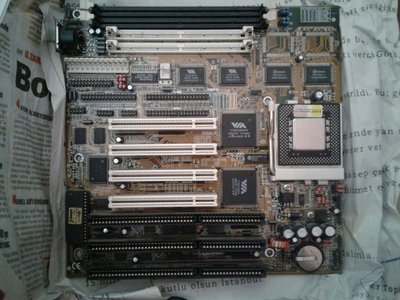appiah4 wrote:Bottom line is, 64MB should be enough for anybody? (For a K6-2 Windows 98SE gaming build targeting 1998 at the very least?)
The VPX isn't a 1998 chipset but a very early 1997 one, and this was one of the periods when that really mattered. When the VPX came out, it was before the launch of the K6; for most tasks a Cyrix MII was probably the fastest CPU around (unless you actually used your FPU), otherwise the new, shiny and very expensive Pentium MMX was the way to go. Most systems would have been equipped with 16MB or 24MB of RAM, with 32MB reserved for the real high-end.
Now fast-forward to Windows 98SE. That puts you not in 1998 but mid 1999, so two and a half years later. Chances are you'd have a Celeron 300A and be trying to run it at 450MHz on a BX board, or if you had cash to burn you might have an early Pentium III. If money was tight you'd have a later K6-2 on a SuperSo7 platform. Entry-level RAM would be 64MB, with 128MB being standard on a performance system.
So trying to run Win98SE on an early 1997 system is like trying to run Windows 95 on a 1992-era 486 (or indeed Windows XP on that same Celeron Mendocino with 128MB RAM...). Yes, it was possible, but you'd have to push the platform to its limits, sink a lot of good money on maxing legacy stuff (old RAM mainly) and still results would be disappointing. That was true in 1999 and is still true today.
feipoa wrote:dionb wrote:Via's VPX is generally comparable to the i430VX, so a definite step back in terms of performance compared to the TX. Also it shared the VX's extreme pickyness when it comes to SDRAM. You only get the 128MB cachable area if you switch to write-through, further reducing performance.
Do you happen to have any benchmark numbers with regard to WB vs. WT for L2 cache on the VX? Wiki mentions 64 MB as being the max cacheable on the VX. https://en.wikipedia.org/wiki/List_of_Intel_c … entium_chipsets
I have something, but it's hardly authoritative. Back in the 2000s I did a load of memory performance benchmarks of the various So5/7 chipsets, always using the same Pentium 100 and 2x 32MB EDO or 1x 64MB SDRAM. One of the issues was that different boards had very different memory settings, so in the end I settled on doing a "conservative" run with everything set as slow as possible and a "performance" run with everything as fast as I could get it stable. After a while it became clear this was pretty pointless as of course the amount you could enable/disable varied as much as the settings, so it was still comparing apples and oranges - and I went with the 'performance' figures for comparison. But I kept doing both settings because I had started it so I would finish it. In the case of the VPX one of the 'conservative' settings was setting L2 from WB to WT - although there was a lot more than that (general RAM timings tight/loose). I used a FIC PA-2010+ for VPX, and tested with RAMspeed INTmem and FLOATmem.
Results are here, with the difference between the "C" and the "P" run being about 30%. But once again, that is bigger than just WB vs WT.
I'm not aware of any better figures for regular PCs though - googling found an academic paper on WB vs WT on a MIPS RISC platform...
